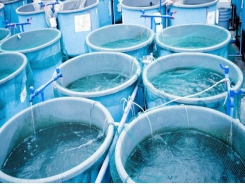CPTPP has a positive impact on Vietnams shrimp exports

Shrimp exports in the first months of 2019 decreased compared to the same period last year. The Comprehensive and Progressive Agreement for Trans-Pacific Partnership (CPTPP) took effect from the beginning of 2019 and has been impacting Vietnam’s shrimp exports to member countries
Vietnam’s shrimp exports to CPTPP countries are thriving. Photo: T.H
Exports decrease
According to Vietnam Association of Seafood Exporters and Producers, in the first four months of 2019, the value of Vietnam’s shrimp export reached 848.4 million USD, decreasing by 16.7% compared to the same period in 2018.
Besides the challenges, there are positive impacts on the export of Vietnamese shrimp to members of the CPTPP.
CPTPP has more marketable products and faster, easier time to reduce taxes. So, after the CPTPP took effect, Vietnam’s shrimp export turnover to member markets such as Japan, Canada, Australia and Singapore have not changed much but it recorded some positive changes.
Japan was the second largest shrimp import market of Vietnam in the first four months of 2019, accounting for 19.2% of the total export value. In February and March of this year, Japan was the only market among the major import markets for Vietnamese shrimp which recorded positive growth. In April, shrimp exports to Japan decreased due to reduced demand in the context of economic growth showing signs of deceleration and an unstable yen. In the first four months of this year, shrimp exports to Japan reached 162.5 million USD, down 7.3% compared to the same period in 2018. Exports to the EU, US, China and South Korea also decreased.
In addition to the Vietnam-Japan (VJEPA) and ASEAN-Japan (AJCEP) FTAs, the CPTPP helps Vietnamese shrimp to increase their advantages in this market. According to Japan's commitments in the CPTPP, most of Vietnam's seafood products including frozen shrimp (HS 030617) and processed shrimp (HS 160521) are entitled to a 0% tax rate immediately.
Increasing exports to CPTPP countries
Canada ranked 6th in Vietnam's shrimp imports, making up 4.4% of the total export value of Vietnamese shrimp. In the first four months of this year, Vietnam shrimp exports to Canada reached 37.6 million USD, up 4.8% compared to the same period in 2018. Shrimp exports to Canada showed signs of increasing after the CPTPP took effect earlier this year.
Among the countries participating in the CPTPP, Canada is one of the countries with the highest market access commitments with thousands of tariffs for imported goods returning to 0%, with a tax cut of up to 95% on a number of tariffs, covering 78% of Vietnam's total export turnover to Canada. Canada is one of three member countries with whom Vietnam has no bilateral trade agreement.
Under the CPTPP, import duties on aquatic products, including frozen shrimp, processed shrimp from Vietnam to Canada fell to 0% immediately after the agreement took effect.
The CPTPP provides an opportunity for Vietnamese shrimp in the Canadian market because competitors such as India, Thailand and Indonesia are not in the agreement.
In recent years, Canada has consumed more warm water shrimp from Southeast Asian countries in the context of a declining supply of cold-water shrimp. Exporting Vietnamese shrimp to Canada is at the top of the supply and accounting for nearly 1/3 of the market share of imports. With this advantage, the CPTPP will be a force to help Vietnam compete.
Australia ranked 7th in Vietnam’s shrimp imports, accounting for 4.8% of Vietnam's total shrimp exports. Under the commitments in the CPTPP, all exported shrimp products to Australia are at 0% immediately after the agreement took effect.
One of the other member countries is Chile. This is a small market which has a big opportunity for Vietnamese shrimp. According to Chile's commitments in the CPTPP, seafood products including imported shrimp to Chile were reduced from 6% to 0% as soon as the agreement took effect.
In the first three months of 2019, Vietnam’s shrimp exports to Chile reached 712,400 USD, a strong increase of 1.465% compared to the first three months of 2018 (turnover only reached 45,500 USD). Chile from the 60th position in the top markets of Vietnam shrimp imports rose to 46th position with the proportion increased to 0.12% from 0.01%.
Effective CPTPP sets out for enterprises the conditions of technical barriers, quality standards and rules of origin. Enterprises need to improve competitiveness, capture market information and barriers to promptly respond.
Thus, after the CPTPP takes effect, its benefits for Vietnam shrimp export are not much, but it is considered necessary support factors to help improve the points that the previous bilateral and multilateral agreements are not yet available.
Có thể bạn quan tâm
Phần mềm

Phối trộn thức ăn chăn nuôi

Pha dung dịch thủy canh

Định mức cho tôm ăn

Phối trộn phân bón NPK

Xác định tỷ lệ tôm sống

Chuyển đổi đơn vị phân bón

Xác định công suất sục khí

Chuyển đổi đơn vị tôm

Tính diện tích nhà kính

Tính thể tích ao hồ



 Self-farming aquaculture? It’s closer than you think
Self-farming aquaculture? It’s closer than you think  Aquaculture system changes influence soybean use
Aquaculture system changes influence soybean use